Managing Wildlife Populations
Cougar Capture: Wildlife Biologist Prince and Officer Kirsch assisted Wolf Biologist Roussin with locating and releasing a subadult cougar caught in a wolf trap. Cougars can be tricky to find after being caught in a foothold trap, due to their tendency to be extremely still and quiet once tangled in vegetation. The cougar was released unharmed.
Bighorn Sheep: District Biologist Wik learned of approximately 150-200 domestic weed goats along the Snake River about 15 miles south of Asotin, approximately three miles from Black Butte bighorns. District Biologist Wik visited the site and was not able to communicate with the herder on site or contact a landowner. The goats were observed moving onto county property, which led District Biologist Wik to contact the county planner. In the end, the goats left the site as the job was complete. District Biologist Wik talked with one of the owners of the goats who seem to have mixed information regarding disease risk to bighorns.
Chronic Wasting Disease Sample: Natural Resource Technician Harris collected a Chronic Wasting Disease (CWD) sample from a buck harvested in Game Management Unit 111.
Grouse: Biologists Lowe and Brinkman deployed grouse barrels prior to the start of the grouse hunting season. These barrels are placed at three different locations in District 2 and will be available for hunters to voluntarily submit a wing and tail from each harvested grouse during the open season. These samples will be used to identify species, sex, and age of each grouse and provide Washington Department of Fish and Wildlife with valuable information about the population structure of grouse on the landscape.
The barrel at Inland Empire Paper Company’s Thompson Creek gate will likely be removed mid-season as the road is not maintained in winter. Grouse season opened on Sep. 15 for the third consecutive year, as this delayed start has been shown to decrease disproportionate harvest of brood hens that occurs with earlier season openers in other regions.

Chronic Wasting Disease Testing: Natural Resource Technician Heitstuman checked local pits for CWD samples. Two unreported road killed deer were recovered and disposed of due to advanced decomposition and tissue damage to the glands needed for CWD testing.
Deer Surveys: Wildlife Area Assistant Manager Rimmelspacher and Wildlife Area Manager Finch conducted their first deer survey for the month of September. During the month of August, they conducted two deer surveys over the same 70-mile route. They reported a high percent of legal bucks and many fawns which included one set of triplets and few sets of twins.
Providing Recreation Opportunities
Trail Maintenance: Sherman Creek Wildlife Area Natural Resource Technician Zueger and Wildlife Area Assistant Manager Palmer finished cleaning off the popular trail that runs from Sherman Creek Wildlife Area headquarters south to Haag Cove along the Columbia River. They cleared off piles of pinecones and needles they had made earlier and removed encroaching brush as well.
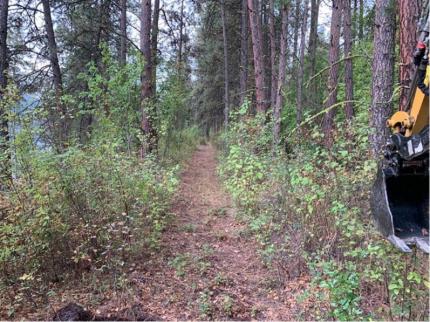

Mentored Pheasant Youth Hunt: Acting Private Lands Biologist Nizer coordinated with Pheasants Forever to put on a mentored pheasant youth hunt on four hunt by reservation properties in Whitman County. Nizer planted 20 birds for the youth hunt. In total there were eight kids that showed up to the hunt with their parents. Nizer talked about the access program to the group of hunters and explained how they can gain hunting access for the future.
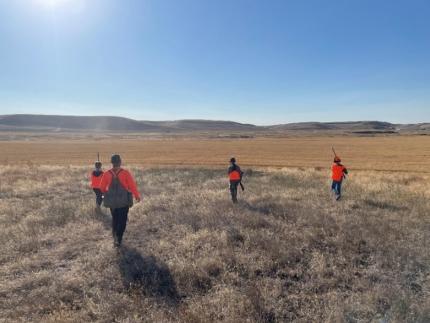
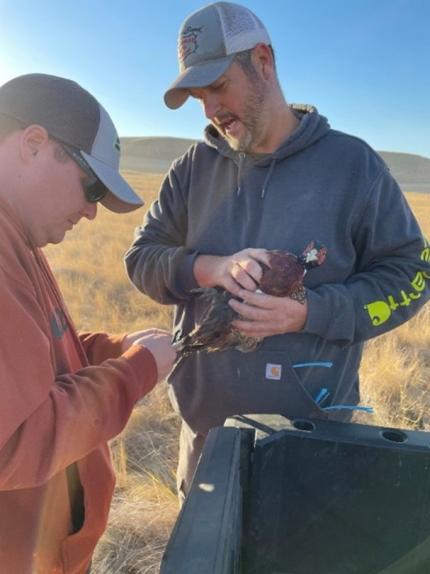

Asotin Creek Wildlife Area Parking Improvement: Atlas Sand and Rock delivered and roughly spread ten truckloads of gravel at the South Fork shed lot. Technician Nielsen spent the better part of the day using the access area tractor and land plane leveling and smoothing the new gravel surface. The lot is often used by horseback riders using the trail up the South Fork of Asotin Creek. Hunters and other wildlife area users also frequently park vehicles there.

Waitts Lake Maintenance: Dziekan and Brant spent Wednesday at the Waitts Lake Access Area, catching up on deferred maintenance. Lawn grass had grown as far as one foot over the sidewalk, so Dziekan purchased an edging hand tool and Brant used it to cut back the turf. The pair cleared the fence line of brush growing through the wire. They also pruned several trees to open sight lines and keep low-hanging vegetation from hitting them when they’re on the mower. The pair filled their dump trailer with green waste, just from that site. Dziekan sprayed herbicides for broadleaf and grass control, as part of his work on removing unwanted vegetation from the gravel parking area and around the boulder, so that it looks nicer and saves staff members from having to string-trim.

Blue Green Algae Blooms: Rainbow Lake has cleared up and appears to be past the risk of blue green algae returning. The Columbia County Health Department finally got back to Wildlife Area Manager Dingman with the results of the water samples and all the lakes were below detectable levels.
Providing Conflict Prevention and Education
Wolf Activity: Wildlife Conflict Specialist Wade was contacted by a landowner who has property that borders the Umatilla National Forest. The landowner had captured trail camera pictures of the WA139 group on his property. The picture appears to be taken after Washington Department of Fish and Wildlife lethally removed two adult wolves from the pack. The producer emailed the pictures to Wildlife Conflict Specialist Wade after the conversation.

Moose Hazing: Acting Private Lands Biologist Nizer and Natural Resource Technician Rumiser hazed three moose in two different locations. One bull moose was from the St. John area. The cow and calf were in the Garfield area, but a total of six moose were counted throughout the day. Both groups were hazed by firing paintball guns at them to move them off the landowner properties so they would no longer cause a danger to the homeowners.

Beaver Damage: Wildlife Conflict Specialist Kolb received a report of commercial crop damage from beavers in Walla Walla County. The producer agreed to explore relocation efforts and Wildlife Conflict Specialist Kolb contacted a licensed relocator. A site visit is tentatively set for the end of next week for further evaluation.

Producer/Sherriff Check-ins: Wildlife Conflict Specialist Wade followed up with the affected producer, range rider, and County Sheriff regarding the depredation investigation that was conducted last week.
Radio Activated Guard Box: Natural Resource Technician Harris set up and tested a new radio activated guard box in preparation for deployment in northern Stevens County following multiple confirmed wolf depredation events.
Night Pen Construction: Natural Resource Technician Harris and Wildlife Conflict Specialist Samsill built a night pen for a landowner's sheep. The night pen was funded in conjunction with Defenders of Wildlife following multiple sheep depredations involving several different cougars. Staff members will return later to finish enclosing the night pen and install electric fence in the sheep pasture.
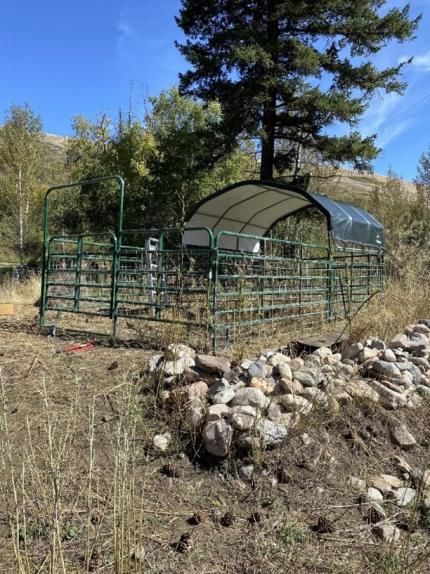
Conserving Natural Landscapes
Habitat Funding: Natural Resource Technician Harris submitted a draft contract to utilize turkey tag money for a turkey habitat restoration project to be conducted in spring 2024.
Swanson Lakes Wildlife Area fall food plots: Wildlife Area Assistant Manager Rimmelspacher spent time planting a fall food plot with separate strips of winter triticale and winter canola.
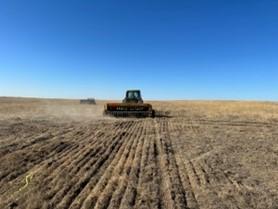
Cummings Creek Fire: A lightning storm on Sep. 7 caused a fire on the W. T. Wooten Wildlife Area to pop up on Sep. 8. The local Department of Natural Resource crews were quick to get on the fire and ordered an abundance of aircraft to help get the fire under control. The fire only burned 84 acres on Hatchery Ridge above the Tucannon Fish Hatchery. The Wildlife Area Manager responded to the wildlife area the afternoon of Sep. 8 to function as a natural resources advisor for the fire and to close the road to Rainbow Lake to allow the helicopters to dip out of the lake for fire suppression. She submitted all the necessary documentation when she came back to the office on Sep. 11.




Providing Education and Outreach
Hunter Education: Wildlife Conflict Specialist Kolb put up posters around the area communities about hunter education opportunities in Walla Walla and Touchet Valley.
Dayton Fair: Acting Private Lands Biologist Nizer worked the chronic wasting disease trailer at the Dayton Fair to inform the public about the disease.

Wildlife Area Advisory Committee meeting: On Thursday, Wildlife Area Manager Finch and Wildlife Area Assistant Manager Rimmelspacher held their 2023 Wildlife Area Advisory Committee meeting at the Swanson Lakes Wildlife Area office. There were approximately 20 people in person and four that attended via Teams. There were many topics that were covered between the Swanson Lakes, Revere, and Reardan Audubon wildlife areas. Region 1 Wildlife Program Manager Robinette spoke on the topic of separating the wildlife areas with new managers and how and why that decision was made. Access Manager Dziekan gave a power point presentation on Waikiki Springs and the new Chapman Lake parcel. Access Manager Dziekan’s presentation was very detailed with a lot of information that described the history of both parcels. The Bureau of Land Management Spokane District Wildlife Biologist Lowe gave a presentation on the test results of the invasive grass herbicide test that was conducted at Swanson Lakes Wildlife Area this past season. Ducks Unlimited Biologist Blewett spoke on the wetland projects at the Revere Wildlife Area which included the Phase 1 portion that began in 2020 and the Phase 2 portion will be coming soon to increase the open water for migrating birds.

Conducting Business Operations and Policy
Columbia Plateau Wildlife Management Association Meeting: Acting Private Lands Biologist Nizer, District Wildlife Biologist Lowe, Assistant Wildlife Biologist Brinkman, and Officer Copenhaver met with Columbia Plateau Wildlife Management Association board members to discuss and draw tags for the Landowner Hunting Permits (LHP) for the upcoming hunting season and to introduce new folks to the board members.
